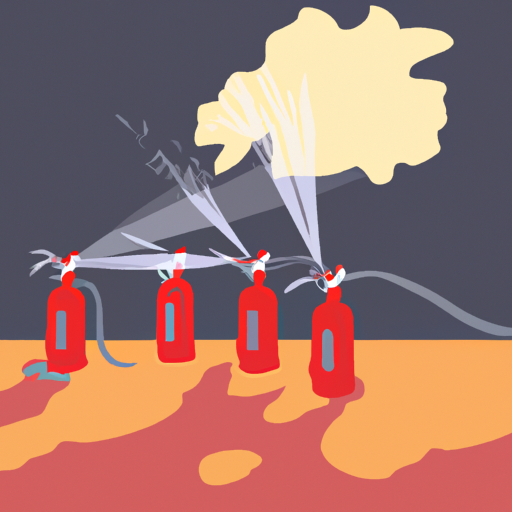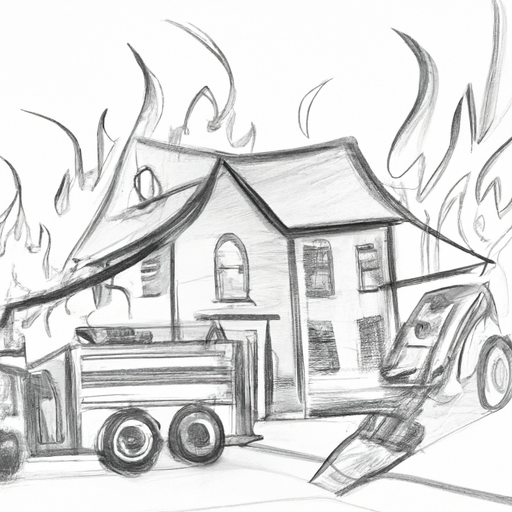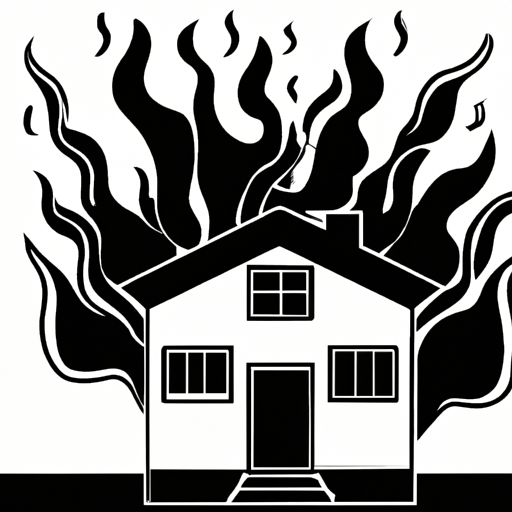Fire insurance is designed to protect individuals and businesses from financial losses caused by fire-related incidents. It covers the cost of repairing or rebuilding damaged structures, replacing lost belongings, and covering additional expenses. Coverage can vary, so it’s important to carefully read and understand the terms and conditions of a policy. Fire insurance is evolving due to changing risk factors and advancements in technology, and regular reassessment and updating of coverage is necessary. The industry is facing significant changes and emerging trends, including increased premiums and deductibles, additional coverage options, and the integration of technology and data analysis. The increasing frequency and severity of wildfires due to climate change are driving these changes, and technology is being used for innovative solutions in risk assessment, prevention, and mitigation.
Fire insurance is a crucial aspect of protecting one’s property and financial security. As the risk of fire continues to pose a significant threat, understanding the ins and outs of fire insurance is more important than ever. This article aims to provide a comprehensive overview of fire insurance, discussing its coverage, benefits, and recent changes in the industry. Additionally, it will explore the evolving landscape of fire insurance, including the impact of technological advancements and climate change. Whether you are a homeowner, business owner, or simply interested in insurance trends, this article will equip you with the knowledge needed to navigate the complex world of fire insurance.
- 1. Understanding Fire Insurance: An Introduction to Coverage and Benefits
- 2. Exploring the Scope of Fire Insurance: What Does It Cover?
- 3. The Evolving Landscape of Fire Insurance: Recent Changes and Trends
- 4. Navigating the Future of Fire Insurance: How Technology and Climate Change are Shaping the Industry
1. Understanding Fire Insurance: An Introduction to Coverage and Benefits

Fire insurance is a type of property insurance that provides coverage against damages caused by fire. It is designed to protect individuals and businesses from financial losses resulting from fire-related incidents.
The primary purpose of fire insurance is to provide financial assistance for repairing or rebuilding damaged structures, replacing lost or damaged belongings, and covering additional expenses incurred due to fire. This includes costs such as temporary accommodation, debris removal, and the loss of business income during the period of recovery.
Fire insurance policies typically cover the physical structure of a property, including the building itself, as well as any attached structures such as garages or sheds. It also covers personal belongings and valuable items that may be damaged or destroyed in a fire, such as furniture, electronics, and clothing.
Additionally, fire insurance may extend coverage to surrounding structures on the property, such as fences, walls, or outdoor equipment. Some policies may even provide coverage for damage caused by smoke or water used to extinguish the fire.
It is important to note that fire insurance coverage varies from policy to policy, and it is crucial for individuals to carefully read and understand the terms and conditions of their specific policy. Some policies may have certain exclusions or limitations, such as coverage for arson-related fires or intentional acts.
In recent years, the nature of fire insurance has been evolving due to changing risk factors and advancements in technology. With the increasing frequency and intensity of wildfires, insurance companies have been reevaluating their coverage options and pricing strategies. Some areas prone to wildfires may experience higher premiums or even denial of coverage altogether.
Furthermore, advancements in fire prevention and detection technology have led to the development of smart fire alarms and sprinkler systems. These innovations can help reduce the risk of fire and minimize damage. As a result, insurance companies may offer discounts or incentives for installing such preventive measures.
Another important aspect of fire insurance is the need for regular reassessment and updating of coverage. As property values change over time, it is crucial to ensure that the coverage reflects the current
2. Exploring the Scope of Fire Insurance: What Does It Cover?

Fire insurance is a type of property insurance that provides coverage for damages caused by fire. It is designed to protect individuals and businesses from the financial burden that can result from a fire-related incident. While the specific coverage can vary depending on the insurance provider and policy, there are some common elements that are typically covered by fire insurance.
First and foremost, fire insurance generally covers the cost of repairing or rebuilding a property that has been damaged by fire. This includes the structure itself, as well as any fixtures and fittings within the property. It also covers the cost of replacing or repairing personal belongings that have been damaged or destroyed by fire, such as furniture, electronics, and clothing.
In addition to property damage, fire insurance often provides coverage for additional expenses that may arise as a result of a fire. This can include temporary accommodation costs, as well as the cost of removing debris and cleaning up after the fire. It may also cover any loss of income or business interruption that occurs as a result of the fire, helping individuals and businesses to recover financially while they get back on their feet.
It is important to note that fire insurance typically covers other perils as well, such as lightning strikes, explosions, and smoke damage. Some policies may also provide coverage for water damage resulting from efforts to extinguish the fire, as well as damage caused by vandalism or theft during or after the fire.
However, it is crucial for policyholders to carefully review the terms and conditions of their fire insurance policy, as there may be certain exclusions or limitations to coverage. For example, some policies may not cover fires caused by arson or intentional acts, while others may exclude coverage for certain types of properties or high-risk areas.
Furthermore, the scope of fire insurance coverage is constantly evolving and changing. With advancements in technology and an increased understanding of fire risks, insurance companies are continually reassessing their policies and updating their coverage options. This includes offering additional coverage for specific risks, such as wildfires or electrical fires, as well as
3. The Evolving Landscape of Fire Insurance: Recent Changes and Trends

The landscape of fire insurance has undergone significant changes and witnessed emerging trends in recent years. With the increasing frequency and severity of wildfires and other fire-related disasters, insurance companies have had to adapt and revise their policies to meet the evolving needs of property owners.
One notable change in fire insurance is the rise in premiums and deductibles. As the risk of fires has escalated, insurance companies have had to reassess their pricing models to ensure they can cover potential losses. This has resulted in higher premiums for policyholders, particularly those residing in high-risk areas prone to wildfires. Additionally, insurance companies have implemented higher deductibles, shifting more of the financial burden onto the policyholders in the event of a fire.
Another trend in fire insurance is the inclusion of additional coverage options. As the understanding of fire risks expands, insurance companies have started offering specialized coverage for specific fire-related damages. This may include coverage for smoke damage, water damage from firefighting efforts, and even coverage for the loss of landscaping or outdoor structures due to fire.
Furthermore, insurance companies have begun incorporating technology and data analysis into their fire insurance policies. With the advancement of satellite imagery and predictive modeling, insurers can assess the risk of fire in a certain area more accurately. This enables them to tailor coverage and pricing based on specific risk factors, such as proximity to fire-prone areas or the presence of flammable materials nearby.
In recent years, there has also been a push for increased transparency and education in fire insurance. Insurance companies are more actively engaging with policyholders, providing them with information on fire prevention, safety measures, and steps to mitigate risks. By empowering property owners with knowledge, insurers aim to reduce the likelihood and severity of fire-related claims.
Moreover, the concept of community resilience has gained traction in the fire insurance sector. Efforts are being made to foster collaboration between insurers, local governments, and communities to develop strategies that enhance fire prevention and response measures. This includes initiatives such as incentivizing homeowners to implement fire-resistant building materials or
4. Navigating the Future of Fire Insurance: How Technology and Climate Change are Shaping the Industry

As the world continues to grapple with the effects of climate change, the insurance industry, including fire insurance, is undergoing significant changes. Technology and climate change are shaping the future of fire insurance, forcing both insurers and policyholders to navigate new challenges and opportunities.
One of the key factors influencing the fire insurance industry is the increasing frequency and severity of wildfires. As global temperatures rise and weather patterns become more unpredictable, wildfires are becoming more common and destructive. This has led to an increased demand for fire insurance coverage, as well as higher insurance premiums.
To effectively navigate the changing landscape of fire insurance, insurers are turning to technology for innovative solutions. For instance, advanced modeling techniques and data analytics are being employed to assess the risk of wildfires and determine appropriate coverage and premiums. This allows insurers to better understand the potential impact of climate change on their portfolios and make informed decisions.
Additionally, technology is playing a crucial role in improving the efficiency and effectiveness of fire prevention and mitigation efforts. Remote sensing technologies, such as drones and satellite imagery, can quickly detect and monitor wildfires, enabling early response and minimizing damages. Insurers are also using artificial intelligence and machine learning algorithms to analyze vast amounts of data and identify patterns that can help predict and prevent fires.
Moreover, technology is revolutionizing the claims process, making it faster, more transparent, and less burdensome for policyholders. Mobile apps and online platforms allow policyholders to easily file claims, track the progress, and receive real-time updates. This streamlines the claims handling process and enhances customer satisfaction.
However, while technology offers numerous benefits, it also presents challenges for the fire insurance industry. Insurers must invest in the necessary infrastructure and expertise to effectively leverage technology. Additionally, the reliance on technology raises concerns about data privacy and cybersecurity, as insurers handle sensitive customer information.
In conclusion, the future of fire insurance is being shaped by the dual forces of technology and climate change. Insurers are utilizing advanced technologies to assess risks, prevent fires, and streamline claims processes
In conclusion, fire insurance is a crucial aspect of protecting individuals and businesses from the devastating consequences of fire damage. This article has provided an introduction to fire insurance, outlining its coverage and benefits. It has also explored the scope of fire insurance, highlighting the various aspects it covers. Moreover, the article has discussed the evolving landscape of fire insurance, addressing recent changes and trends in the industry. Lastly, it has shed light on the future of fire insurance, emphasizing the role of technology and climate change in shaping the industry. As advancements continue to be made and environmental factors become increasingly significant, it is evident that fire insurance will continue to adapt and evolve. It is essential for individuals and businesses to stay informed about these changes in order to ensure they have the appropriate coverage to protect their assets. By understanding the intricacies of fire insurance and staying updated on industry developments, individuals and businesses can make informed decisions to safeguard their properties and assets against the unpredictable threat of fire.

